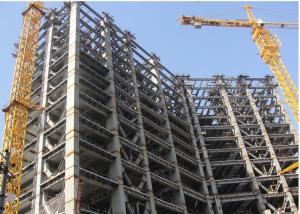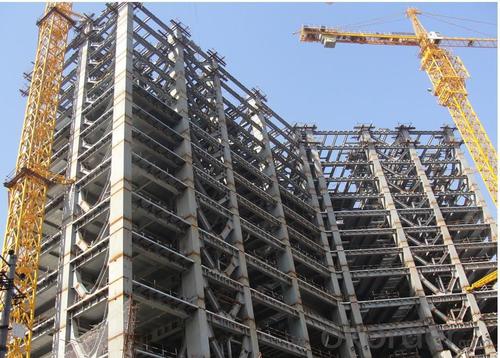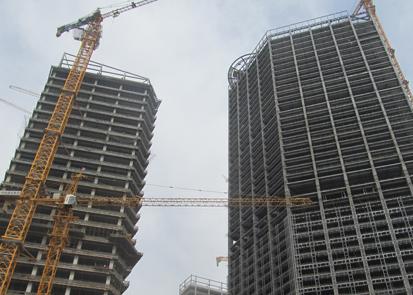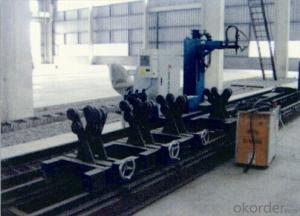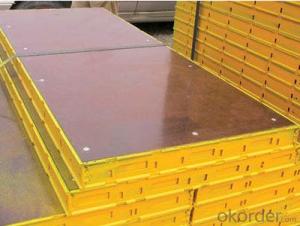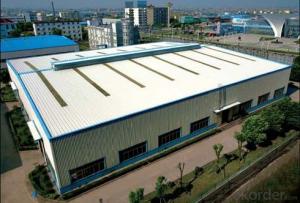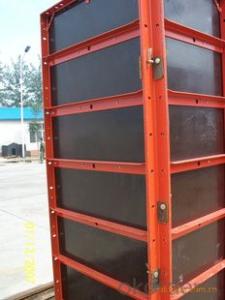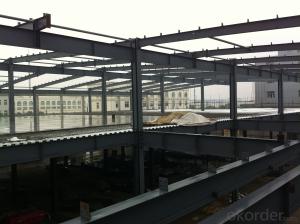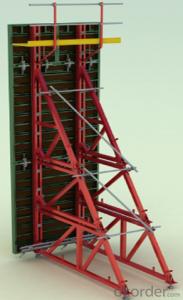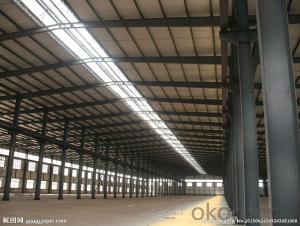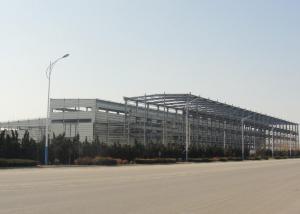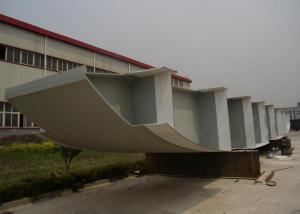Steel Building Construction
- Loading Port:
- Tianjin Port
- Payment Terms:
- TT or LC
- Min Order Qty:
- 1 set m.t.
- Supply Capability:
- 5000MTONS/ Month m.t./month
OKorder Service Pledge
OKorder Financial Service
You Might Also Like
Specifications of steel building construction
Project type: Center building, high-rise building, office building and shopping mall
Building area: 540000 sqm
Height: 206m
Steel material: Q345B
Steel dosage: 25000 t
Structure type: Box column-frame beam, support structure;
The biggest steel plate thickness: 100 mm
|
Grade |
Chemical compositions | ||||
|
C |
Mn |
MAXIMUM(≤) | |||
|
Si |
S |
P | |||
|
Q345B |
≤0.2 |
1.00-1.60 |
0.55 |
0.04 |
0.04 |
|
Mechanical Properties | |||||
|
Yield point |
tensile strength |
Elongation | |||
|
16mm max |
16-40mm | ||||
|
345 |
325 |
470-630 |
21 | ||
1. GB standard material
2. High Structural safety and reliability
3. The production can reach GB/JIS/ISO/ASME standard
Packaging & Delivery of steel building construction
1. According to the project design and the component size, usually the main component parts are nude packing and shipped by bulk vessel. And the small parts are packed in box or suitable packages and shipped by containers.
2. This will be communicated and negotiated with buyer according to the design.
Engineering Design Software of steel building construction
Tekla Structure \ AUTO CAD \ PKPM software etc
⊙Complex spatial structure project detailed design
⊙Construct 3D-model and structure analysis. ensure the accuracy of the workshop drawings
⊙Steel structure detail ,project management, automatic Shop Drawing, BOM table automatic generation system.
⊙Control the whole structure design process, we can obtain higher efficiency and better results
Technical support of steel building construction
|
Worker |
Rate of frontline workers with certificate on duty reaches 100% |
|
Welder |
186 welders got AWS & ASME qualification 124 welders got JIS qualification 56 welders got DNV &BV qualification |
|
Technical inspector |
40 inspectors with UT 2 certificate 10 inspectors with RT 2 certificate 12 inspectors with MT 2 certificate 3 inspectors with UT3 certificate |
|
Engineer |
21 engineers with senior title 49 engineers with medium title 70 engineers with primary title. 61 First-Class Construction Engineers 182 Second-Class Construction Engineers |
|
International certification |
10 engineers with International Welding engineer, 8 engineers with CWI. |
Production Flow of steel structure/steel frame/steel construction
Material preparation—cutting—fitting up—welding—component correction—rust removal—paint coating—packing—to storage and transportation (each process has the relevant inspection)
Usage/Applications of steel structure/steel frame/steel construction
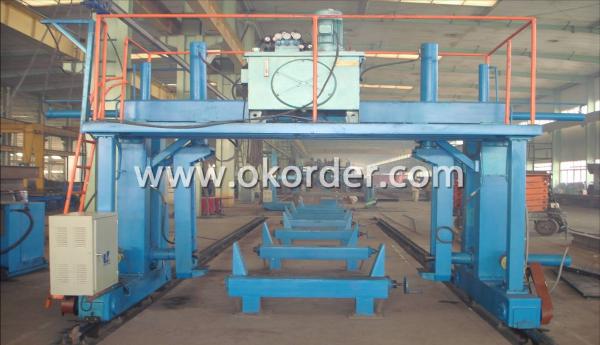
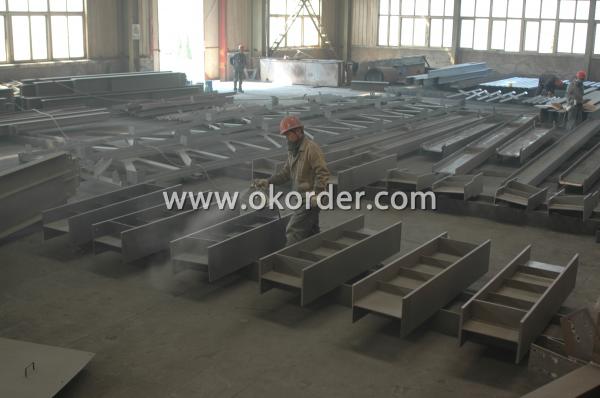
*Characters of Structure Steel
1. Steel is characterized by high strength, light weight, good rigidity, strong deformation capacity, so it is suitable for construction of large-span, super high and super-heavy buildings particularly;
2. It with good homogeneous and isotropic, is an ideal elastomer which perfectly fits the application of general engineering;
3. The material has good ductility and toughness, so it can have large deformation and it can well withstand dynamic loads;
4. Steel structure’s construction period is short;
5. Steel structure has high degree of industrialization and can realize-specialized production with high level of mechanization.
*Steel structure application
1. Heavy industrial plants: relatively large span and column spacing; with a heavy duty crane or large-tonnage cranes; or plants with 2 to 3 layers cranes; as well as some high-temperature workshop should adopt steel crane beams, steel components, steel roof, steel columns, etc. up to the whole structure.
2. Large span structure: the greater the span of the structure, the more significant economic benefits will have by reducing the weight of the structure
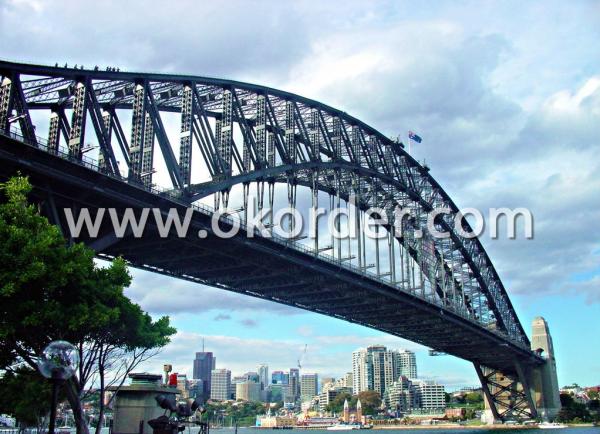
3. Towering structures and high-rise buildings: the towering structure, including high-voltage transmission line towers, substation structure, radio and television emission towers and masts, etc. These structures are mainly exposed to the wind load. Besides of its light weight and easy installation, structure steel can bring upon with more economic returns by reducing the wind load through its high-strength and smaller member section.
4. Structure under dynamic loads: As steel with good dynamic performance and toughness, so it can be used directly to crane beam bearing a greater or larger span bridge crane
5. Removable and mobile structures: Structure Steel can also apply to movable Exhibition hall and prefabricated house etc by virtue of its light weight, bolt connection, easy installation and uninstallation. In case of construction machinery, it is a must to use structure steel so as to reduce the structural weight.
6. Containers and pipes: the high-pressure pipe and pipeline, gas tank and boiler are all made of steel for the sake of its high strength and leakproofness
7. Light steel structure: light steel structures and portal frame structure combined with single angle or thin-walled structural steel with the advantages of light weight, build fast and steel saving etc., in recent years has been widely used.
8. Other buildings: Transport Corridor, trestle and various pipeline support frame, as well as blast furnaces and boilers frameworks are usually made of steel structure.
All in all, according to the reality, structure steel is widely used for high, large, heavy and light construction.
- Q: What are the environmental impacts of steel structure construction?
- The environmental impacts of steel structure construction include the emission of greenhouse gases during the production of steel, deforestation and habitat destruction due to mining for raw materials, and the generation of construction waste. Additionally, the transportation of heavy steel components can contribute to carbon emissions. However, steel structures are highly durable and can be recycled, reducing their overall environmental impact compared to other construction materials.
- Q: How are steel structures used in the construction of storage facilities?
- Steel structures are widely used in the construction of storage facilities due to their numerous advantages. Firstly, steel is known for its high strength-to-weight ratio, making it an ideal material for supporting large and heavy loads. This allows for the construction of spacious storage facilities with minimal material usage, resulting in cost savings. Moreover, steel structures offer superior durability and resistance to various environmental factors. They are highly resistant to corrosion, which is crucial for storage facilities that may house goods sensitive to moisture or other elements. Steel structures also provide excellent protection against fire hazards, as they are non-combustible and can withstand high temperatures. Additionally, steel structures are highly flexible in terms of design and customization. They can be easily modified and expanded to accommodate changing storage needs, making them a highly versatile option. This flexibility also allows for the incorporation of features such as mezzanine floors, overhead cranes, and shelving systems, optimizing the storage capacity and efficiency of the facility. Furthermore, steel structures offer faster construction times compared to traditional construction methods. The use of prefabricated steel components and advanced construction techniques enables rapid assembly, reducing project timelines significantly. This is especially beneficial for storage facilities that need to be operational quickly to meet market demands. In summary, steel structures are extensively used in the construction of storage facilities due to their strength, durability, customization options, and time-efficiency. Their ability to support heavy loads, withstand environmental factors, and accommodate changing storage needs make them a reliable and cost-effective choice for storage facility construction.
- Q: How are steel structures integrated with other building systems?
- Steel structures are integrated with other building systems through a combination of connection methods, such as welding, bolting, or using specialized connectors. This allows for seamless integration and coordination with other systems like electrical, plumbing, HVAC, and architectural components. Additionally, steel structures can be designed to accommodate and support other building systems, ensuring efficient and effective integration throughout the entire construction process.
- Q: How are steel structures designed for resisting blast loads?
- Specific design principles and various strategies can be utilized to enable steel structures to withstand blast loads. The design process involves the consideration of several factors, including the magnitude of the blast, distance from the explosion, type of explosive used, and desired level of protection. An essential aspect of designing blast-resistant steel structures involves selecting suitable materials. High-strength steel, especially those with exceptional ductility and toughness, are frequently employed to ensure the structure's ability to endure the dynamic forces generated during a blast event. The selection of steel grade and thickness is meticulously evaluated to guarantee the structure's capacity to absorb and dissipate energy. Another crucial factor is the structural configuration. Blast-resistant steel structures often incorporate reinforced concrete cores or walls to provide additional strength and stability. The utilization of steel bracing, moment-resisting frames, or trusses can also enhance the structure's resilience against blast loads. Furthermore, the design incorporates various protective measures. These measures may include the implementation of blast-resistant windows, doors, and panels to mitigate the effects of pressure waves and flying debris. The inclusion of blast-resistant glazing systems, such as laminated or tempered glass, can prevent shattering and reduce the risk of injuries. Moreover, the overall design of the steel structure takes into account its dynamic response to blast loads. This entails evaluating the structure's natural frequencies, dynamic amplification, and potential failure modes. Sophisticated computer simulations and finite element analysis are often employed to assess the structural response and optimize the design. In conclusion, the design of steel structures to withstand blast loads necessitates a comprehensive approach that considers material selection, structural configuration, and protective measures. By adhering to these principles and implementing appropriate design strategies, steel structures can effectively withstand the devastating forces of a blast event.
- Q: What are the different types of steel columns and beams used in construction?
- There are several different types of steel columns and beams used in construction, including I-beams, H-beams, box columns, and wide flange columns. These structural elements are commonly used for their strength, durability, and ability to support heavy loads in various building projects.
- Q: What is the cost comparison between steel structures and other construction materials?
- The cost comparison between steel structures and other construction materials can vary depending on various factors such as project size, location, design complexity, and market conditions. However, steel structures are generally considered to be cost-effective due to their durability, versatility, and faster construction times. While steel may have a higher upfront cost compared to materials like wood or concrete, its long-term benefits often outweigh the initial investment. Additionally, steel structures require less maintenance and are less susceptible to damage from pests, fire, and weather, resulting in potential cost savings over time.
- Q: What are the common challenges in steel structure construction?
- Some common challenges in steel structure construction include the need for precise and accurate measurements, ensuring proper alignment and fit of the steel components, managing the weight and load-bearing capacity of the structure, addressing corrosion and rust prevention, and coordinating various trades and contractors involved in the construction process.
- Q: How are steel structures designed for resisting fire-induced thermal expansion?
- Steel structures are designed to resist fire-induced thermal expansion through several key measures. First and foremost, the selection of materials plays a crucial role. Fire-resistant steel, such as those with a high melting point, are commonly used in the construction of these structures. This ensures that the steel can withstand high temperatures without significant deformation or failure. Additionally, the structural design takes into account the potential expansion and contraction of steel due to fire. Engineers incorporate expansion joints and flexible connections within the steel framework to allow for thermal expansion. These joints and connections absorb the expansion and prevent excessive stress on the structure, reducing the risk of failure. Fire protection measures, such as the application of fire-resistant coatings or the use of fireproof insulation, are also employed to safeguard the steel structure. These measures provide a layer of insulation that slows down the transfer of heat to the steel, delaying its temperature rise and minimizing thermal expansion. Furthermore, the design of steel structures often incorporates fire safety features, such as compartmentalization and fire barriers. These features divide the structure into smaller sections, limiting the spread of fire and reducing the overall thermal load on the steel. By controlling the fire's impact and minimizing the heat exposure, the thermal expansion of the steel can be effectively managed. In summary, steel structures are designed to resist fire-induced thermal expansion through the use of fire-resistant materials, the incorporation of expansion joints, the application of fire protection measures, and the implementation of fire safety features. These design considerations ensure that the steel structure can withstand high temperatures and minimize the risk of failure during a fire event.
- Q: What are the considerations for steel structure design in mountainous areas?
- When designing steel structures in mountainous areas, there are several important considerations that need to be taken into account. These considerations include: 1. Topography: The unique topography of mountainous areas can present challenges for steel structure design. The steep slopes, uneven terrain, and varying elevation levels require careful planning and engineering to ensure that the structure is stable and can withstand the forces exerted by the natural environment. 2. Seismic activity: Mountainous areas are often prone to seismic activity, such as earthquakes. Steel structures in these regions must be designed to withstand the shaking and ground motion associated with earthquakes. This involves incorporating seismic design principles, such as ensuring proper connections, using flexible structural systems, and considering the potential for liquefaction or landslides. 3. Snow loads: Mountainous areas typically experience heavy snowfall, particularly at higher elevations. Designing steel structures in these regions requires accounting for the additional load imposed by the weight of snow on the roof and other horizontal surfaces. This includes considering factors such as snow accumulation, wind drift, and the shape of the structure to prevent excessive snow buildup and potential collapse. 4. Wind loads: Mountainous areas can also be subject to strong winds, especially in exposed locations or at higher altitudes. Steel structures need to be designed to resist these wind loads by considering factors such as wind speed, direction, and the shape of the structure. This may involve adding additional bracing, strengthening connections, or using aerodynamic design features. 5. Temperature variations: Mountainous areas often experience significant temperature variations, with colder temperatures at higher elevations. Steel structures must be designed to withstand these temperature changes, which can cause expansion and contraction of the material. Proper consideration of thermal expansion and contraction, as well as the selection of appropriate materials, is essential to ensure the structural integrity of the steel components. 6. Environmental impact: Building in mountainous areas requires careful consideration of the surrounding environment. This includes minimizing the impact on natural habitats, preserving the integrity of water bodies, and avoiding soil erosion. Designing steel structures with minimal disturbance to the natural landscape and using sustainable construction practices can help mitigate the environmental impact. In conclusion, designing steel structures in mountainous areas requires a thorough understanding of the unique challenges posed by the topography, seismic activity, snow loads, wind loads, temperature variations, and environmental impact. By carefully considering these factors, engineers can design structures that are safe, resilient, and compatible with the natural environment.
- Q: How are steel structures used in power plants?
- Steel structures are widely used in power plants due to their strength, durability, and versatility. They play a crucial role in supporting heavy machinery, equipment, and infrastructure required for power generation. One of the primary uses of steel structures in power plants is for the construction of the main building or powerhouse. Steel frames are used to create a robust skeleton that supports various components, such as turbines, generators, boilers, and cooling systems. These structures can withstand the immense weight and vibrations generated by these machines, providing a safe and stable environment for their operation. Steel structures are also used in the construction of storage facilities within power plants. These facilities store fuel, such as coal or natural gas, which is used for power generation. Steel tanks and silos are commonly used to store and protect these materials from the elements. The high strength and corrosion resistance of steel make it a suitable choice for such applications. Furthermore, steel structures are used for the construction of transmission towers and electrical substations within power plants. Transmission towers are responsible for supporting high-voltage power lines, while substations house transformers and other electrical equipment. Steel's ability to bear heavy loads and resist environmental factors, such as wind and seismic forces, make it an ideal material for these critical structures. In addition to supporting the power generation process, steel structures are also used for auxiliary purposes in power plants. These include walkways, platforms, and staircases that provide safe access to various areas within the plant for maintenance and inspection activities. Overall, steel structures are essential in power plants as they provide the necessary strength and stability to support heavy machinery, store fuel, and facilitate the transmission and distribution of electricity. Their versatile nature makes them a popular choice for the construction of power plants worldwide.
1. Manufacturer Overview
| Location | SHANDONG,China |
| Year Established | 2008 |
| Annual Output Value | Above US$20 Billion |
| Main Markets | WEST AFRICA,INDIA,JAPAN,AMERICA |
| Company Certifications | ISO9001:2008;ISO14001:2004 |
2. Manufacturer Certificates
| a) Certification Name | |
| Range | |
| Reference | |
| Validity Period |
3. Manufacturer Capability
| a) Trade Capacity | |
| Nearest Port | TIANJIN PORT/ QINGDAO PORT |
| Export Percentage | 0.6 |
| No.of Employees in Trade Department | 3400 People |
| Language Spoken: | English;Chinese |
| b) Factory Information | |
| Factory Size: | Above 150,000 square meters |
| No. of Production Lines | Above 10 |
| Contract Manufacturing | OEM Service Offered;Design Service Offered |
| Product Price Range | Average, High |
Send your message to us
Steel Building Construction
- Loading Port:
- Tianjin Port
- Payment Terms:
- TT or LC
- Min Order Qty:
- 1 set m.t.
- Supply Capability:
- 5000MTONS/ Month m.t./month
OKorder Service Pledge
OKorder Financial Service
Similar products
Hot products
Hot Searches
Related keywords
